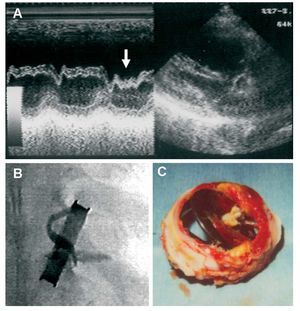A 56-year-old woman was urgently admitted following an episode of syncope. Fourteen years earlier, she had undergone implantation of a tricuspid prosthesis due to Ebstein anomaly, with congestive heart failure (NYHA class III) and severe tricuspid regurgitation. A mechanical prosthesis had been selected (31-mm Medtronic-Hall® valve; Medtronic Inc., Minneapolis, Minnesota, USA) because of its structural tolerance and the relatively young age of the patient. Since that time she had been taking warfarin daily to maintain the international normalized ratio between 2.5 and 3.5. Transthoracic echocardiography showed intermittent posterior movements of the interventricular septum during diastole (Figure, A). Cineradiography confirmed an intermittent opening movement of the tilting disc, despite the fact that the opening angle was patent (Figure, B). We were concerned that the intermittent posterior movement of the interventricular septum might be caused by intermittent entry flow due to poor functioning of the mechanical valve.
Figure.
Surgery was immediately performed to replace the old device with a 31-mm Hancock® bioprosthesis (Medtronic Inc.). The explanted prosthesis was covered by a thrombus (Figure, C). It is known that late thrombus is a serious complication of mechanical tricuspid valves. Intermittent posterior movement of the interventricular septum is uncommon and was the key factor that led us to diagnose a serious complication in a mechanical tricuspid prosthesis.


